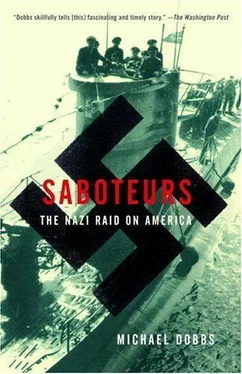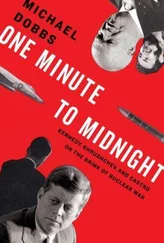While the Gestapo investigated his case, Burger was confined to a cell with sixty other inmates and no open windows. His assistant was also arrested. But the worst part, he told Dasch, was the harassment of his wife, whom Burger had recently married and who was pregnant with their first child. The Gestapo urged Bettina to file for a divorce, telling her that her husband had stolen money from the state and would be sentenced to eight years on a chain gang. As it turned out, the Justice Ministry eventually dropped the charges against Burger and ordered him to report to the army. But Bettina was so shaken by the Gestapo’s tactics she had a miscarriage. In return for his freedom, Burger had to sign a declaration promising never to speak of his experiences in prison.
Although Dasch knew about Burger’s prison record, he had never heard the full story, nor understood the depth of his hatred for Himmler and the Gestapo. They both sensed they were feeling each other out, dancing around a previously taboo subject.
“Boy,” Dasch said finally. He habitually called anyone whom he perceived as junior to him “Boy,” even at the risk of causing offense. “Boy, I have a lot to talk to you about. There’s something I need to tell you, but I need to put you through some tests first.”
“I know what you are going to tell me.”
“If you know what I want to tell you, then you will have to kill me.” 26
Burger smiled. “I am quite sure that our intentions are very similar,” he said.
By this time, the restaurant was getting crowded, and the diners at the next table could hear their conversation. They decided to leave. Dasch suggested a stroll through Manhattan to see the sights. They walked north in the direction of Times Square and Radio City.
As they joined the crowds of New Yorkers, wandering away from the tail end of the big parade along Fifth Avenue, the two men did not resume their unfinished conversation from the restaurant. Instead, Dasch began telling Burger about his political beliefs, and the “socialist ideals” inculcated in him by his mother. He was vague about what these ideals actually meant, other than a belief in the power of well-led masses to effect human progress.
By way of illustration, Dasch suggested they look at the murals in the entrance of the seventy-story RCA building in Rockefeller Center, one of the most impressive of the skyscrapers rising from the center of Manhattan. The murals depicted “The March of Civilization,” and there was quite a history behind them. Originally, John D. Rockefeller Jr. had commissioned the Mexican artist Diego Rivera to paint the murals, but he became upset over Rivera’s inclusion of a portrait of Lenin, symbolically clasping the hands of a Red Army soldier and an American Negro. This was unacceptable to the apostle of American capitalism, and he ordered Rivera’s murals to be ripped out of the ceiling.
In place of the communist morality tale, Rockefeller commissioned a capitalist morality tale from another Mexican artist, José Maria Sert. As they looked at the soaring ceiling, Dasch and Burger could see the figures of Lincoln and Emerson in the place previously occupied by Lenin. On one part of the ceiling, planes circled in ever-tighter loops, causing spectators below to feel almost giddy. Elsewhere, oppressed slaves were rising up against their masters and well-muscled workers were building a futuristic city in the sky. The overall effect was a paean to the productive capabilities and industrial might of a free society.
The paintings, Dasch informed Burger gravely, illustrated “the history of mankind from the early days of slavery to the present.” 27The two of them were destined to be part of the never-ending struggle for a better world.
They did not get back to their hotel until nearly midnight. It had been an extraordinarily full day, beginning nearly twenty-four hours earlier on a deserted beach, and they were both exhausted. As they headed up to their rooms, Dasch said he would explain his ideas more fully in the morning.
CHAPTER SEVEN
HIGH STAKES (JUNE 14–17)
THE FOLLOWING MORNING, Sunday, Dasch invited Burger to his room for breakfast. After they finished eating, he pushed the breakfast cart out into the hall, locked the door, tossed the key into the bathtub, and closed the bathroom door as well. Then he walked over to an open window, fourteen stories above the Manhattan street, and announced that if the two of them were unable to come to an understanding, “either I go out the window or you go out the window.” 1
“I want the truth, nothing else, regardless of what it is. If we can’t agree, we will have to fight it out.”
Burger, accustomed by now to Dasch’s melodramatics, looked at him with the same knowing smile as the evening before. “There is no need for either of us to go out the window because we both feel very much the same way.” 2
They still had to tell each other their life stories, Dasch insisted. Only then would they find out whether they had similar opinions about the mission on which they had been sent. Ever loquacious, he launched into his own biography, beginning with his experiences as a fifteen-year-old guard at a German prisoner of war camp in northern France during World War I. In the camp, he told Burger, he became friendly with a Corporal Fensch, a man more than twice his age who, prior to the war, had been a philosophy student at the University of Munich. Fensch converted the impressionable young Dasch to communism.
After arriving in the United States in 1922, Dasch went on, he tried his hand at various jobs and became actively involved in union politics. He soon became disillusioned with the American Communists he met, despite sharing many of their ideals. He investigated various political ideologies, finally concluding that the ideology of Hitler’s National Socialist Party most closely matched his own. When World War II broke out, he thought it would be “yellow” to remain behind in America, and decided to return to Germany “to find out what it was all about.” 3
It did not take him long to realize he had made a big mistake. Disenchantment began to set in on the long boat trip from San Francisco to Japan and Russia, on the first leg of his journey back to Germany. There were many enthusiastic Nazi Party members on the boat, among them Werner Thiel, now a member of the second group of saboteurs that would be landing in Florida. At first, the Nazis were relatively subdued. But after the boat left Honolulu en route to Japan, they grew bolder and started “singing German songs and boasting of the way they were going to fight the English.” Dasch, whose English was better than his German, found the regimented atmosphere on board the Tatuta Maru “distasteful” and refrained from joining the other passengers in their enthusiastic Heil Hitlers. A self-appointed gauleiter for the rest of the group denounced him as a spy and threatened to report him to the authorities on their return to Germany.
Arriving in Berlin in May 1941—eighteen months into the war—he was dismayed by living conditions in Germany, which were much worse than he had expected. Even though the German army had won some spectacular military victories, Berliners seemed “suspicious and afraid” of each other. 4Food shortages were already quite noticeable and graft and terror were rampant. Dasch told Burger about an accountant friend who worked in a bank and was reprimanded when he raised questions about the bank accounts of high Nazi Party officials.
He went on to describe how he had got a job monitoring American propaganda broadcasts for the German Foreign Office. He was amazed to find out how many people listened to these broadcasts, despite the risk of imprisonment if they were caught. It was an important lesson in the power of propaganda. At the same time, he felt that American propaganda to Germany could be much more effective. Instead of trying to win over ordinary Germans disillusioned with the hardships of life under Hitler, American broadcasters insulted them by lumping all Germans together as “Nazis.” Dasch’s dream, he told Burger, was to “lick the Nazis with their own weapons” by persuading the Americans to employ more sophisticated propaganda techniques.
Читать дальше












